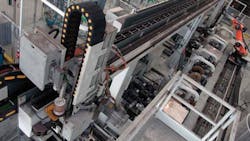Troubleshooting Challenge: Proportional-Valve Inconsistency
A simple circuit was designed to lift large castings on an elevator from a conveyor at floor level to another conveyor located high in the building. The elevator used a pressure-compensated pump with a three-position proportional-directional valve, filters, and a relief valve for safety. A limit switch was used at each end of the elevator’s stroke to signal the proportional valve’s amplifier card to decelerate until the elevator stopped. The elevator had a hard stop at the lower conveyor position and relied on the proportional valve and limit switches for the stopping position at the upper conveyor. A hard stop at the top would cause the casting to move out of position and jamb the conveyor.
The amplifier card had four separate ramp adjustments, so acceleration and deceleration in both directions could be adjusted independent of each other. An average weight casting was used to set the ramp speeds as well as the final lifting and lowering speeds.
The proportional valve used was ordered with an LVDT option for electronic spool position feedback to ensure accurate spool positioning. The project engineer noticed during installation and debugging that if a casting with a different weight was used, the elevator cylinder’s stopping point at the upper position would vary, causing a jam. Heavier castings caused the elevator to stop short of the desired position, and lighter ones caused the elevator to overshoot the desired stopping point.
The engineer could adjust the deceleration ramps to fix the problem so production could resume, but as soon as a lighter or heavier casting needed to be lifted, adjustments were required again.
If the proportional valve spool would go to the same open position with ½% accuracy due to the LVDT option, why did the stopping point change as much as 2 in. when the casting weight changed?
Solution to proportional valve inconsistency
Many engineers mistakenly think the use of a proportional valve for speed control gives precise and consistent speeds. They feel the spool positioning is very accurate and repeatable when LVDT feedback devices on the main spool are used. However, an expensive proportional valve is no better than a plain, old-fashioned needle valve. The flow will change if the pressure drop across the valve changes.
When castings of different weights in this application were used, the load pressure on the outlet of the proportional valve changed, causing the flow across the valve spool to change. The addition of a pressure compensating “Hydrostat” module placed under the proportional valve solved this problem. The “Hydrostat” makes the proportional valve pressure compensated, so it ignores load changes — just the same as a pressure-compensated flow control valve does.
This file type includes high resolution graphics and schematics when applicable.
About the Author
Robert Sheaf
President
Robert J. Sheaf Jr., is the founder and president of CFC Industrial Training, formerly Certified Fluid Consultants, part of CFC-Solar Inc. CFC-Solar provides technical training, consulting, and field services to any industry using fluid power technology.

Leaders relevant to this article:

